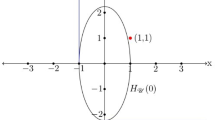Abstract
Second-order sensitivity analysis methods are developed for analyzing the behavior of a local solution to a constrained nonlinear optimization problem when the problem functions are perturbed slightly. Specifically, formulas involving third-order tensors are given to compute second derivatives of components of the local solution with respect to the problem parameters. When in addition, the problem functions are factorable, it is shown that the resulting tensors are polyadic in nature.
Similar content being viewed by others
References
R.L. Armacost and A.V. Fiacco, “Computational experience in sensitivity analysis for nonlinear programming,”Mathematical Programming 6 (1974) 301–326.
R.L. Armacost and A.V. Fiacco, “Sensitivity analysis for parametric nonlinear programming using penalty methods,” in:Computers and Mathematical Programming, National Bureau of Standards Special Publication 502 (1978) pp. 261–269.
G.A. Bliss,Lectures on the calculus of variations (University of Chicago Press, Chicago, 1946).
R.S. Dembo, “Sensitivity analysis in geometric programming,”Journal of Optimization Theory and Applications 37 (1982) 1–21.
J.E. Falk, “Global solutions of signomial problems,” Technical report T-274, George Washington University, Department of Operations Research, (Washington, DC, 1973).
J.E. Falk and R.M. Soland, “An algorithm for separable nonconvex programming problems,”Management Science 15 (1969) 550–569.
A.V. Fiacco and G.P. McCormick,Nonlinear Programing: Sequential Unconstrained Minimization Techniques (Wiley, New York, 1968).
A.V. Fiacco, Sensitivity analysis for nonlinear programming using penalty methods,”Mathematical Programming 10 (1976) 287–311.
A.V. Fiacco, “Nonlinear programming sensitivity analysis results using strong second order assumptions,” in: L.C.W. Dixon and G.P. Szego, eds.,Numerical Optimization of Dynamic Systems (North-Holland, Amsterdam, 1980), pp. 327–348.
A.V. Fiacco,Introduction to Sensitivity and Stability Analysis in Nonlinear Programming (Academic Press, New York, 1983).
J.J. Filliben, “DATAPLOT—an interactive high level language for graphics, nonlinear fitting, data analysis and mathematics,”Computer Graphics 15 (1981) 199–213.
A. Graham,Kronecker Products and Matrix Calculus with Applications (Wiley, New York, 1981).
K.L. Hoffman, “NUGLOBAL—User Guide,” Technical report TM-64866, George Washington University, Department of Operations Research (Washington, DC, 1975).
R.H.F. Jackson, “Tensors, Polyads, and High-Order Methods in Factorable Programming,” Dissertation, The George Washington University, Department of Operations Research (Washington, DC, 1983).
R.H.F. Jackson and G.P. McCormick, “The polyadic structure of factorable function tensors with application to high-order minimization techniques,”Journal of Optimization Theory and Applications 51 (1986) 63–94.
R.H.F. Jackson, G.P. McCormick and A. Sofer, “FACTNLS, a factorable programming system for nonlinear least squares problems,” National Bureau Standards Working Paper, to appear.
J. Kyparisi, “Sensitivity and stability for nonlinear and geometric programming: theory and applications. Dissertation, The George Washington University, Department of Operations Research (Washington, DC, 1983).
S.G. Leaver, “Computing global maximum likelihood parameter estimates for product models for frequency tables involving indirect observation,” Dissertation, The George Washington University, Department of Operations Research (Washington, DC, 1984).
A. Linneman, “Higher-order necessary conditions for infinite and semi-infinite optimization,”Journal of Optimization Theory and Applications 38 (1982) 483–511.
W.H. Marlow,Mathematics for Operations Research (Wiley, New York, 1978).
G.P. McCormick, “Second order conditions for constrained minima,”SIAM Journal of Applied Mathematics 15 (1967) 37–47.
G.P. McCormick, “Computability of global solutions to factorable nonconvex programs: Part I—Convex underestimating problems,”Mathematical Programming 10 (1976) 147–175.
G.P. McCormick,Nonlinear Programming: Theory, Algorithms and Applications (Wiley, New York, 1983).
G.P. McCormick, “Global solutions to factorable nonlinear optimization problems using separable programming techniques,” Technical Report NBSIR 85-3206, National Bureau of Standards (Gaithersburg, MD, 1985).
L. Pennisi, “An indirect proof of the problem of Lagrange with differential inequalities as added side conditions,”Transactions of the American Mathematical Society 74 (1953) 177–198.
Author information
Authors and Affiliations
Additional information
Research sponsored by contract N00014-86-K-0052, US Office of Naval Research.
Rights and permissions
About this article
Cite this article
Jackson, R.H.F., Mccormick, G.P. Second-order sensitivity analysis in factorable programming: Theory and applications. Mathematical Programming 41, 1–27 (1988). https://doi.org/10.1007/BF01580751
Received:
Revised:
Issue Date:
DOI: https://doi.org/10.1007/BF01580751




